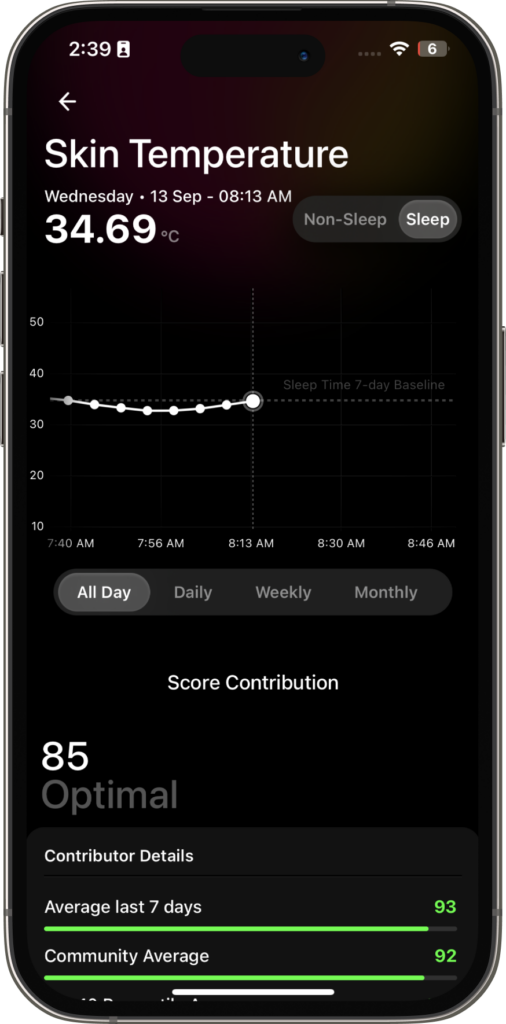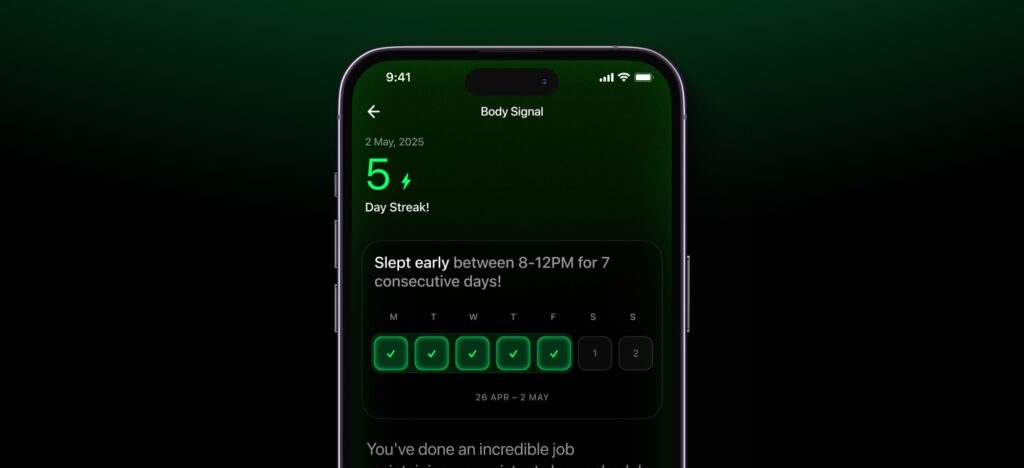Highlights
- The Ring AIR’s Dynamic Recovery is an aggregate measure of five parameters determining your body’s preparedness for the next day and changes throughout the day. It is a percentage measure from 0-100, a higher (85 or above) number indicating better recovery.
- The Dynamic Recovery has five factors which include – Sleep quotient, temperature, stress rhythm, temperature, resting heart rate and HRV form
- Dynamic Recovery is dynamic and can be improved throughout the day by regulating stress, maintaining good sleep and sleep hygiene, proper exercise routine, eating balanced and timely meals, hydrating well and including cold therapy and active recovery.
Do you ever feel like you don’t have enough energy to carry on with your day? Or do you wake up from an 8-hour-long sleep only to feel exhausted? We associate extra hours put in for work or working out with better or even faster gains. When the focus shifts to bettering health, we add exercise and nutrition to mix and assume the ‘rest’ will work itself out.
The reality is far from this.
An equally important factor that often flies under the radar is recovery. Any optimal exercise routine will include ample rest and recovery, giving your body enough time to repair, rebuild and strengthen itself before you restart the loading process again.

While workouts are designed to help you make gains, the actual gains only occur in your rest and recovery. Without this, your body either continues to store toxins, breaks down or gets injured, all of which are counterproductive for improved physical and mental well-being.
Moreover, your recovery is directly tied to your metabolism. Studies have shown that sleep deprivation can alter the glucose metabolism and hormones involved in regulating metabolism, decreasing leptin levels and increasing ghrelin levels. (4) Similarly, if your body doesn’t get enough rest post-workout, it can also affect your HRV and other parameters.
But anything that needs improvement first needs to be measured. So how do you measure recovery, and what does its measurement entail? A Dynamic Recovery is an accurate and aggregate measure that helps gauge this.

What is Dynamic Recovery?
Dynamic Recovery includes multiple parameters determining your rest and activity levels for the next day. It recognizes your body’s state of recovery by analyzing your sleep, heart rate (HR), heart rate variability (HRV), and temperature. It recommends NSDR, naps, stress rhythm, and breathwork sessions, but also recognizes shifts in your markers and adapts the score in real-time.
With dynamic recovery, you’ll know how much your body can endure or how much rest it requires. The score is a percentage measure from 0-100; a higher score indicates better recovery.
How is it calculated?
Ultrahuman Ring AIR calculates the dynamic recovery based on five factors – sleep, stress rhythm score, temperature, resting heart rate and HRV. Each factor further has its measurement indices to arrive at individual values.
If any of these values change, the overall score dwindles, showing you exactly what you need to improve on.
What are the different factors of the Dynamic Recovery?
1. Sleep Quotient
Adequate sleep is an imperative part of physical and mental well-being.
Sleep affects almost every organ and organ system of the body, including the brain, heart, lungs, metabolism and immune system, among others.
During sleep, your body focuses on repairing DNA breaks caused during waking hours and expels toxins from neurons that otherwise harm your body.
There are various stages of sleep an individual goes through, such as REM and non-REM sleep, all of which are captured for calculating the dynamic recovery. Each stage of sleep impacts your metabolism, changing your muscle tone and hormone levels. The duration and quality of your sleep will determine how quickly your body is primed to take on more strain.
Tracking sleep quality requires deep insights into the various stages of sleep, rendering useful insights on how they can be improved.
Ultrahuman Ring AIR gives you a holistic picture of your sleep quality, contributors of which are sleep efficiency, total sleep, REM sleep, deep sleep and sleep timing. These, coupled with your heart rate value, arrive at an assessment of your total sleep quality. (1)

2. Stress Rhythm
Stress Rhythm tells you if you’re ‘stimulated’, ‘relaxed’, or ‘stressed’. Based on these states, you can leverage stress at your body’s peak tolerance to drive focus and productivity and avoid stress at your body’s lowest tolerance for better rest and sleep quality. It considers the variations of Heart Rate (HR), Resting Heart Rate (RHR), and Heart Rate Variability (HRV) through each of the phases of your circadian rhythm.
A higher score means that you are regulating your stress well and are working with your circadian rhythm. A lower score conveys that you have dysregulated stress, and are potentially working against your circadian rhythm.
3. Temperature
During the day, our body’s temperature varies. Body temperature is at its lowest a few hours before we wake up. This variation is a direct outcome of your body’s metabolic activity, which is lowest during sleep and increases as the day progresses.
Slowing down your metabolism is your body’s way of lowering your core temperature before and during sleep. Studies indicate that a drop in core temperature induces drowsiness, an essential aspect of sleep quality. (11)
Sickness and workouts spike your body temperature.
Relaxation and recovery reduce your body temperature.
Your body has 15% skin weight. This weight plays a crucial role in regulating body temperature.
Through thermoregulation, the skin either traps or expels bodily heat.
The skin constricts its capillaries when the body is trying to preserve heat. Similarly, the skin dilates its capillaries when the body is trying to release heat.
Measuring skin temperature is an accurate representation of the body’s core temperature and, therefore, of recovery.

4. Resting Heart Rate
When your body is resting, your heart is performing at its bare minimum to supply oxygen to your body through blood. This means the heart has to pump blood fewer times per minute because it pumps larger volumes per beat.
A lower resting heart rate implies lower stress on your heart. A healthy individual has a resting heart rate of 60-100 beats per minute.
An increase in resting heart rate implies your body needs more vigorous physical activity or more rest.
Each individual’s resting heart rate is different. Ultrahuman Ring AIR considers the individual’s baseline to determine the deviation in resting heart rate. (2)
5. HRV Form
HRV, or Heart Rate Variability, is the variation in the time interval between consecutive heartbeats in milliseconds. If your heart’s BPM (beats per minute) is 60, it doesn’t mean it beats at one beat per sec.
The intervals could vary massively, and this variation is HRV. HRV indicates many things in your body’s adaptability and mental state. The higher the HRV score, the better the recovery and health.
Ultrahuman Ring AIR’s dynamic recovery, considers your HRV patterns and deviations from these patterns to decode and assess your health.
How to improve your dynamic recovery?
Here are some things you can do to improve your dynamic recovery:

1. Improve your sleep and sleep hygiene
Sleep impacts multiple facets of the human body and its functioning.
- Sleep for 7-9 hours
- Get restful sleep
- Keep a regular sleep and waketime
- Turn off or reduce exposure to blue-light devices at least an hour before bedtime
- Make the room dark
- Keep a cold sleep environment
- Avoid caffeine
- Get sunlight exposure upon waking
These are just some ways to improve your sleep quality, ultimately improving your recovery. (3)
2. Improve your exercise routine
Exercising the right way can help improve your recover and metabolic health. Here are some ways:
- Get moderate to vigorous physical activity
Moderate to vigorous exercise reduces the onset of sleep during waking hours which helps regulate your circadian rhythm (sleep-wake cycle). - Use active recovery on rest days
Active recovery is a great way to help your muscles restore themselves faster. Any low-intensity activity such as walking or swimming, where your heart rate is between 120-140 bpm (zone 2), is excellent for blood flow to your muscles, helping them recover speedily. (10) - Experiment with workout timings
Experimenting with the timing of the workout might give you greater insights into what truly works for your body. The timing of your workout can be personalised depending on what suits your body.
Working out too close to bedtime can increase your stress hormones, preventing you from getting good sleep. Giving your body at least two hours before bedtime will help the endorphins run their course and induce sleep.

3. Align stress with your circadian rhythm
All stress isn’t bad.
Stress is a physiological response to threats or challenges. When your body feels challenged, it prepares for a fight or flight response. However, your body has a cyclical nature influenced by the circadian rhythm. This cyclical nature is deeply tied to the way your body handles stress.
There are certain hours of the day when you can tolerate stress better, and there are hours when the body handles stress poorly. This unique context can help you leverage stress according to your body’s rhythm.
With Stress Rhythm, you can leverage stress to maximise your productivity and optimise its impact on your rest and sleep quality. Stress Rhythm considers the variations in your Heart Rate (HR), Heart Rate Variability (HRV), and Resting Heart Rate (RHR) against your circadian rhythm.

4. Focus on your nutrition
Good nutrition is imperative for muscle recovery. Practising a few simple nutrition guidelines can improve sleep and recovery:
- Limit caffeine and sugary foods
Caffeine and sugary foods consumed after 4 PM can cause wakefulness and hinder sleep quality and routine. - Focus on the timing of food
Eating late at night can severely affect your metabolic health and recovery. Night-time eating causes a spike in your blood glucose and blood pressure, slows your metabolism, and causes weight gain. Instead of focusing on resting, the muscles that digest and metabolise your food are working in overdrive, causing a delay in the onset of sleep and preventing deep, restful sleep. Keeping a 3-hour gap before your last meal and bedtime could prevent this. (14) - Eat a well-balanced diet
Eat a well-balanced diet of macronutrients recommended as per your goals and body type while also using vitamins and supplements such as magnesium.
This improves circulating melatonin, improving your sleep and enhancing muscle recovery. If you are someone who works out regularly, ensure you have 20 to 40 grams of protein (supplement or natural), depending on your body weight to improve muscle gains and recovery. In some cases, if you need to restore your energy levels, you may also consume simple carbohydrates after an intense workout. (7) - Avoid high-carbohydrate meals before bedtime
Moderating your carbohydrate intake at least 4 hours before your bedtime can help regulate nocturnal glucose and, therefore, nocturnal metabolism. Additionally, inflammation caused due to high-carb diets has an adverse impact on HRV, further hindering recovery. (12)(13)
5. Cold Therapy
Reducing inflammation in the body is paramount to improving your metabolic health and recovery. Reduced inflammation leads to a more stable HRV, improving your dynamic recovery.
Exposing your body to extreme cold temperatures may help reduce inflammation. It could be an ice bath, a cryotherapy chamber or even a simple cold water shower. When the body is exposed to such cold temperatures, the blood vessels constrict.
Once you’re out of the cold water or temperature, the blood vessels dilate, quickly flushing out all the metabolic waste. Expose the body to cold therapy for 5-10 minutes a day, all the way from the neck to toe, to reap the benefits of it. (9)
Stay cognizant of the timing of your cold therapy. Ensure you space it out at least 4 hours from your workout time. (15)

6. Hydrate
Water carries nutrients and oxygen to your cells and regulates your body temperature. Optimal nutrition and body temperature are key to recovering well. Also, your blood pressure and heart rate will vary without adequate hydration, leading to more changes in the dynamic recovery.
Studies recommend 200 to 300 ml of water every 20 minutes, especially for working out. However, the amount of water will vary based on activity levels, body type, climate and other factors. (8)
To make it easier to consume more water, you can carry a bottle with you everywhere you go and set an hourly reminder to drink water or consume watery foods.
Conclusion
Recovery is essential to any training routine to help your body get rid of toxins, improving its strength and preparedness for the next day.
Ultrahuman Ring AIR’s dynamic recovery combines five factors – sleep, stress rhythm, temperature, resting heart rate and HRV. Each of these is measured against your personal baseline.
If any of these values change, dynamic recovery gets affected.
To ensure dynamic recovery stays higher than 85 per cent, ensure good sleep quality, exercise regularly but not excessively, include active recovery on rest days, reduce stress, and eat timely and well-balanced meals.
Disclaimer: The contents of this article are for general information and educational purposes only. It neither provides any medical advice nor intends to substitute professional medical opinion on the treatment, diagnosis, prevention or alleviation of any disease, disorder or disability. Always consult with your doctor or qualified healthcare professional about your health condition and/or concerns and before undertaking a new healthcare regimen including making any dietary or lifestyle changes.
References
- DNA Damage Linked to Sleep Deprivation
- What your heart rate is telling you – Harvard Health
- Tips for Better Sleep | CDC
- Sleep and Metabolism: An Overview – PMC.
- Rest and Recovery: How to Let Sore Muscles Heal | Everyday Health
- Hydration to Maximize Performance and Recovery: Knowledge, Attitudes, and Behaviors Among Collegiate Track and Field Throwers.
- The Benefits of Ice Bath After Hard Workouts
- What Is Active Recovery, and How Does It Maximize Your Workout? – GoodRx
- The Temperature Dependence of Sleep
- Effects of Dietary Carbohydrate Profile on Nocturnal Metabolism, Sleep, and Wellbeing: A Review – PMC
- Heart rate variability and inflammation: A meta-analysis of human studies – ScienceDirect
- Heart rate variability and inflammation: A meta-analysis of human studies – ScienceDirect
- The Science & Use of Cold Exposure for Health & Performance – Huberman Lab







